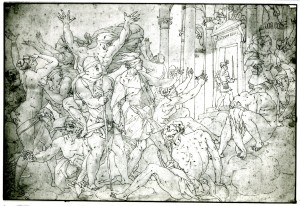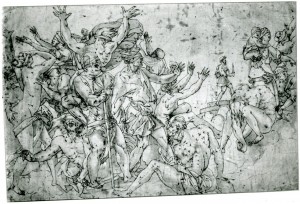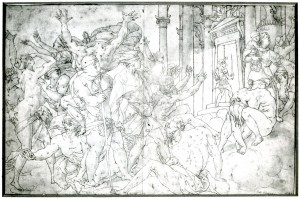For the Fresco in the Gallery of Francis I, Fontainebleau
1535 or 1536
D.61A. Darmstadt, Hessisches Landesmuseum, no. AE 1424.
Pen and ink and wash over traces of black chalk, 28 x 41.9; wm?. Inscribed in ink, on the urn at the left: [B]ONI, on the urn at the right: MALI, and on the lintel of the door: OSTIVM IOVIS.
LITERATURE:
Carroll, 1987, 286, 287, n. 3, under no. 91, 298, under no. 92, as a copy of a lost drawing by Rosso.
Carroll, 1989, 25, Fig. 45.
D.61B. New York, The Pierpont Morgan Library and Museum, Janos Scholz Collection.
Pen and ink and wash (over traces of black chalk?), exact measurements unknown but of the same dimensions as the other copies of D.61 and of the prints of this composition by Fantuzzi and Boyvin (see below); wm?. Inscribed on the verso: a few French words in a sixteenth century hand, one of which may be the name Thiry or Thierry.1 Slightly stained here and there. The composition is incomplete in showing clearly only the three steps of the building.
LITERATURE:
Carroll, 1987, 286, 287, n. 3, under no. 91, 288, under no. 92, as a copy of a lost drawing by Rosso.
D.61C. Rennes, Museum, no. 56/1.
Pen and ink and wash, 27.8 x 42.4; laid down; wm?. Creased down the center. Inscribed in ink, on the urn at the left: [B]ONI, on the urn at the right: MALI, and on the lintel of the door: OSTIVM IOVIS, and at the lower right, also in ink: Rosso Fiorentino f., and in another ink: no 37.
PROVENANCE: Marquis de Robien, entered the museum in 1793.2
LITERATURE:
Rennes, 1863, 85, 56me Cadre, no. 1, as after Rosso.
Carroll, 1987, 286, 287, n. 3, under no. 91, 288, under no. 92, as a copy of a lost drawing by Rosso.
Ramade, in Rennes, 1990, 217, no. 190, as a copy of a lost drawing by Rosso.
As mentioned in P.22, VII S, and in Chapter VIII, these three drawings are derived from a lost study by Rosso for the Enlightenment of Francis I in the Gallery of Francis I. These copies of exactly the same composition show a scene that differs from the fresco in the gallery by representing Caesar without sandals, the woman at the far right with upraised arms nude, and by including the head of a bearded man wearing a turban just right of center between two columns of the building and who appears in the Scholz drawing although it does not reproduce the columns. The Rennes and Darmstadt drawings also show, in addition to the inscription on the lintel of the door that is visible in the fresco, the words [B]ONI and MALI on the urns flanking the door of the building. These do not seem to appear in the painting.
Graphically, the copies show the same kind of penmanship that is found in such drawings as the Annunciation in the Albertina (Fig.D.43a) and the Petrarch drawing at Christ Church (Fig.D.47a), although the execution of none of the Enlightenment drawings is sufficiently expert to be recognized as by Rosso himself. However, the washes in the drawings, which are not consistently alike in all three, are so weak and so indecisively placed as to make it unlikely that they reflect specifically or entirely those of Rosso’s lost drawing. The fact that all three copies do not show the same placement of washes may indicate that the original drawing was not a pen and ink and wash drawing like the Pandora and Her Box (Fig.D.67a), but rather a more complexly executed drawing done also with white heightening and on a dark ground that the copies variously translate into simpler terms. The lost original drawing could have been like the Albertina Annunciation and the Petrarch drawing, and like the original of the lost study for the early version of the Scene of Sacrifice (Fig.D.50B).
As the Enlightenment of Francis I in the gallery would seem to have been designed around 1535 or 1536, so the lost drawing for it would also date from one of these years.
The attribution of the Scholz drawing to Thiry, possibly suggested by an inscription on the verso, is not provable. But a certain caricatural quality of some of the faces in this copy, not found in the others, suggests his hand.
PRINTS: Boyvin, E.12 (Fig.E.12). Engraving based on Rosso’s lost original drawing or on a copy of it.
Fantuzzi, E.74 (Fig.E.74). Etching based on Rosso’s lost drawing or on a copy of it.



